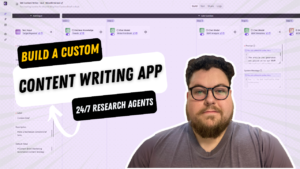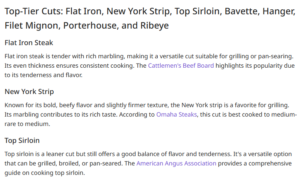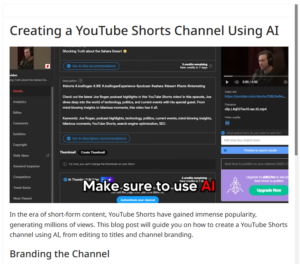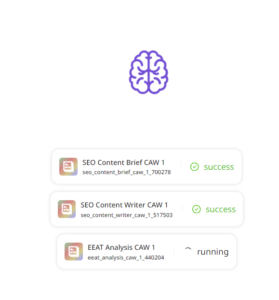This app turns content briefs into written content.
It reviews the content outline, writes the content, and then reviews and edits itself!
It also incorporates brand guidelines and tone settings.
This is a long way from being a complete solution for writing content. However, It’s nice to let AI take the first crack at fleshing out a content brief.
Try it here: 👉 SEO Content Writer App 👈
For best results, use the exact content outline generated from my content outline app.
Note: it can take over 5 minutes to write the page. Let it cook!
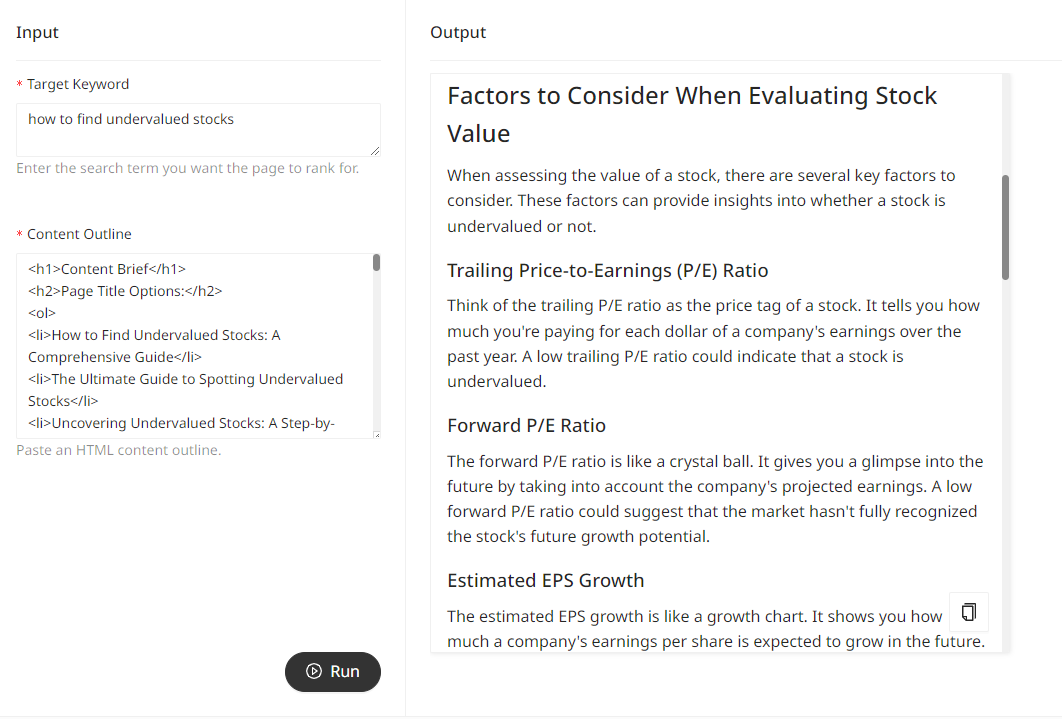
How this app writes SEO content
This is a simple app but all the magic happens behind the scenes.
It’s built with Moonlit, a no-code AI app builder. It’s perfect for automating SEO tasks.
Here’s how it works:
Step 1: Generating the first draft of content.
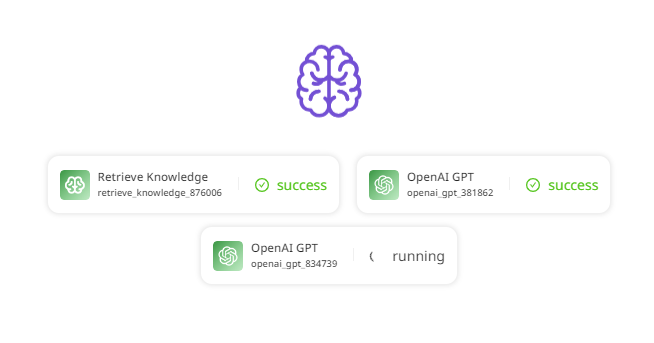
First, the quality of content you get depends largely on your input. If you feed it a thorough brief, it will do a better job.
I recommend using my competitive content brief generator. This content writer app is designed to use the competitive content brief generator as input.
It scans 3 competitors and provides over 20 sections of output. From the heading structure to keyword ideas and more.
Once you feed it a target keyword and content brief, it retrieves the Google Quality Rater Guidelines. Pre-training it on the document from its stored knowledge base.
Then it starts writing
It can take 5-10 minutes depending on the brief.
Step 2: Revise the content
After the first draft, this app uses GPT-4 to revise and edit the content based on a provided checklist.
My content checklist is a built-in EEAT checklist. It checks for Google quality rater guidelines and helpful content guidelines.
 The app aims to revise the content based on meeting these guidelines.
The app aims to revise the content based on meeting these guidelines.
You can swap out the built-in guidelines for your own.
For example, landing page copy guidelines, or product page guidelines.
Fine-Tuning your content outputs
There are four ways you can fine-tune the content output:
1. Customizing the content checklist
You can adjust my content checklist to your preferences.
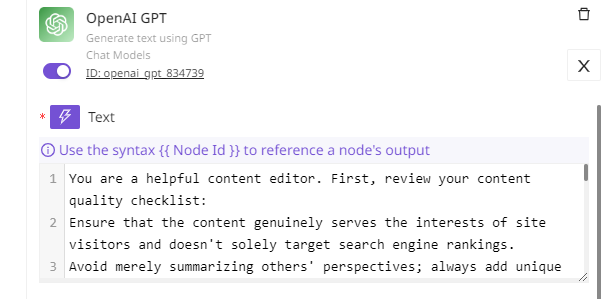
Or you could swap out my content checklist for yours.
2. System message brand guidelines
I included brand guidelines in the system message section.
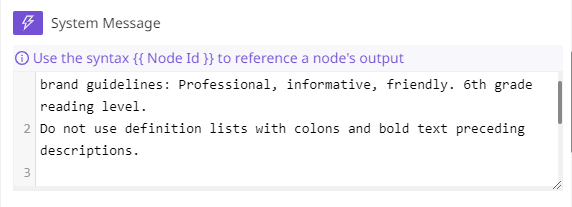
This is the best place to tell GPT a little bit about your brand. For example, your brand name, industry, unique selling propositions, etc.
You can add your guidelines here. For tone, writing style, etc.
3. System message other rules
I added a requirement to exclude definition lists (bold text and colons). These are too common for OpenAI-generated content.
- Definition list: These use bold text and colons, common with AI-generated text.
- This is an unordered list. No bold or colon. Google likes these better.
You can include your own rules here or tell GPT about your brand. This will help ensure it doesn’t choose to write as a competing brand from the content outline.
4. Temperature
You can adjust the temperature settings of the content.
The temperature parameter is a setting in OpenAI’s API. It’s between 0 and 2 that adjusts the randomness of the output.
A lower temperature will result in more predictable output. A higher temperature will result in more random output.
If you want to give GPT-4 more creative freedom, experiment with turning this up a few points.
What to do with your AI-generated content next
If you follow this guide, you should get decent AI-generated SEO content.
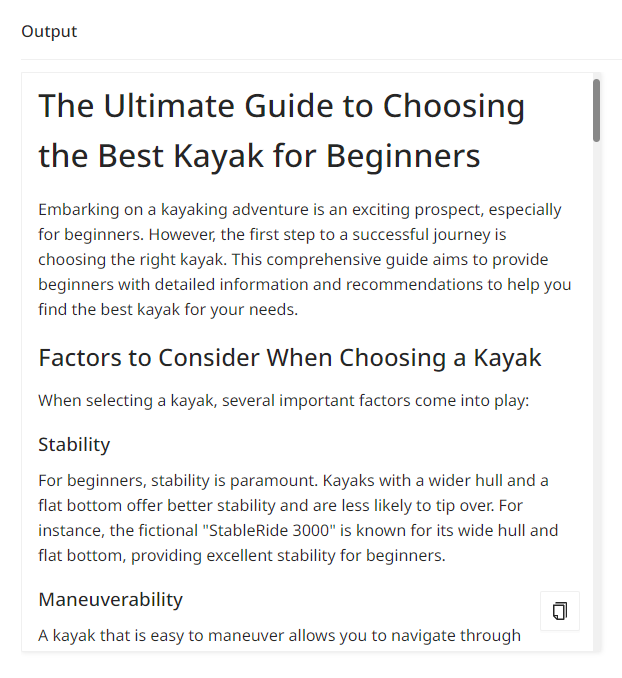
It started as scraped pages. Then became a content outline. Then it was a draft. And finally revised with a checklist.
And all I had to do was pick a target keyword, copy/paste some URLs, and hit run.
Important: this isn’t a complete solution
It’s important to understand that this is not a complete solution to producing content.
This app attempts to create a better page vs what’s already out there. But there are a lot of things AI content can’t do.
For example, this app may make up statistics or fake experiences. You want to replace those with real statistics and link to them. And you should replace fictional experiences with real ones.
Not to mention information gain. You want to go out of your way to bring something new to the table. Instead of just re-phrasing existing content.
Adjust tone and style
Some writers may copy-paste the AI content, claim it as their own, and hit publish. Don’t do that!
Modern writers use an AI-generated page as the new content brief. You should adjust the content to your tone and style.
Writers who focus on high-quality content re-write AI text in their own words. Using AI content as an aid for creativity, structure, and SEO best practices.
The writer focused on quality wins in the long run. Don’t be a copy/paster.
Focus on quality!
Upgrade your content quality
I’m big on content quality. I recommend future-proofing your content with quality revisions.
I’ve developed several apps and resources to help you improve the quality of your content:
- AI-Powered EEAT Featured Snippet Generator
- Matt Diggity’s Giga EEAT Comparison
- AI Quality Rater & Helpful Content Guideline Checker App
- How GPT Can Help You Add First-Hand Experience To Your Pages
- Boost On-Page SEO With YouTube & ChatGPT
- Extract Information Gain From PDFs
- EEAT Perplexity AI Prompts
Review the SEO of your AI content
It’s important to consider that this app’s built-in SEO is entirely left to AI.
Like revising content to better meet your goals, you need to check the SEO of the page.
For example, the content brief generator doesn’t consider keyword search volume.
It only picks keywords based on what the scraped competing pages are using.
A human SEO would focus on certain keywords over others based on volume, intent, etc.
How this app compares to real content generator apps
This app is a pretty cool process. From competitor page scraping to EEAT reviews.
It doesn’t compare to modern-day AI writing tools though.
For example, Tom Winter from SEOwind gave me a demo of his AI content platform. You can customize every input to a tee.
From keywords to headings and FAQ questions. It’s a much more robust solution compared to a DIY app like this.
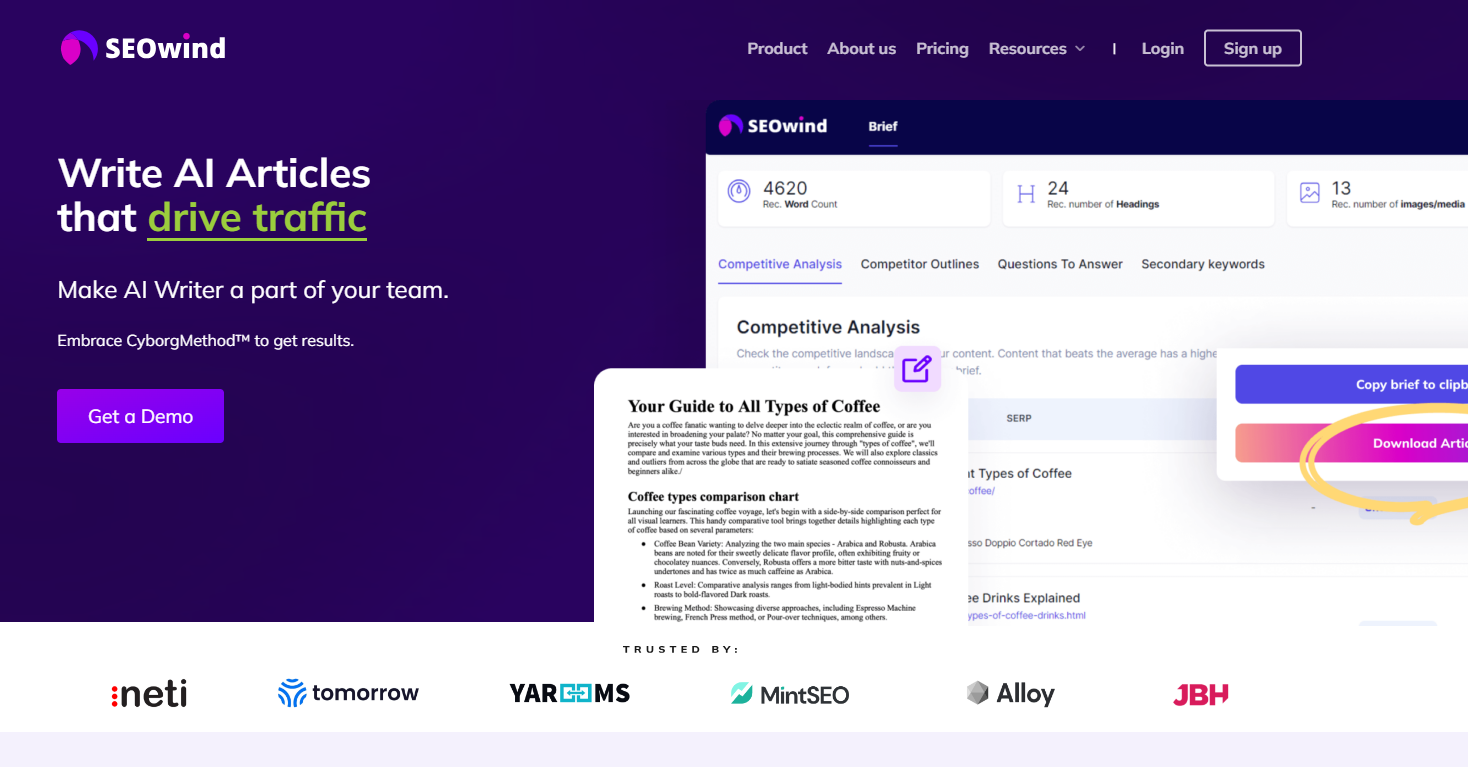
But that doesn’t mean that this app is useless. It still does a decent job and I’m going to test out the content on my AI testing site.
This was also my first content generator app. This is v1.1. I’ll improve it over time.
Google’s stance on AI-generated Content
If you’re unfamiliar with how Google feels about AI content, I’ll sum it up for you.
At first, Google was against AI content and called it spam.
Google later changed its stance on this, saying it’s more about the quality of the content vs how it was made.
This is a fair stance considering AI content is rapidly increasing. Google has billions on the line. They need to keep their stock prices up.
Google’s Quality-focused updates combat AI content spam
Google’s latest updates focus on quality detection. Like the helpful content update, which is a site-wide signal of how helpful your website is.
Or the most recent spam update, which aims to remove plagiarized content from results.
It makes sense that Google is focusing on quality more than ever. Because they are dealing with more quantity than ever.
It’s easier than ever to make crappy content with AI. As a result, Google needs to evolve and adapt to better serve what people are looking for.
SEOs and Google got blamed for ruining the internet
At the same time, SEO made headlines on Vice for ruining the internet. Blaming us for creating garbage pages designed purely to rank. Polluting and distorting the quality of SERPS.
While some people may feel like search results are worse than ever, Google’s stance is that they are better than ever. Considering how complex their algorithms have become over the years and how much work has gone into search.
Google Search Leason Danny Sullivan responded to the Vice article with his thoughts. Saying that the article was missing a lot of important context about both himself and Google.
My thoughts on AI-generated content
AI-generated content works when done right. However, I always take the time to revise my content manually. The manual revision is what makes it rank. AI just speeds up the process.
It’s important to know that OpenAI can’t even tell if their content is AI-generated. But what people don’t realize is that AI-generated content is not all created equal.
The content you publish depends on your processes, prompts, and apps. Everyone has a unique recipe.
Authority matters more than ever
Many people forget to consider the authority of the site producing the content.
If Healthline published an AI-generated page, it’s still going to outrank yours.
Why? EEAT. Healthline is a trusted source for health-related content. Google is very strict about health content.
If inaccurate medical advice is ranked on the SERPS, it could harm users. Exposing Google to legal risk, or bad PR.
Healthline demonstrates lots of experience, expertise, authority, and trust:
- Even if their content was AI-generated, it still has to meet their brand guidelines.
- It still has to go through an editorial process. It has to be fact-checked, and edited.
- They hold themselves to a high standard. AI doesn’t change the set standards.
- They may simply use AI to find efficiencies in their content process.
Generate SEO content and build your own content generator
Test out the content brief generator and SEO content writer. Produce decent SEO content with minimal effort!
If you’re interested in building and customizing apps like this, join the AI SEO academy. You’ll get the guides, prompts, and other resources I use to make these apps.
